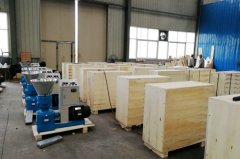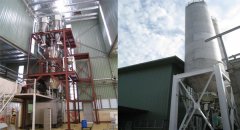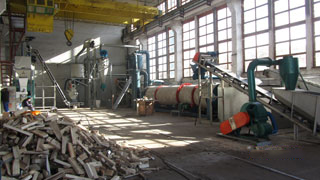Biomass pellet machinery-550 (GMC-ZLSP-R 550B)
GMC-ZLSP-R 550B is a new production designed by our company. Because its production rate can come to 800-1000 kg/h, it is able to meet the need of these customers who require large-tonnage products. Having a simple structure, this machine is easy to operate, and has a high running stability.Features:
- GMC-ZLSP-R 550B, this flat die pellet machine is a new biomass energy equipment which is designed by our company’s technicians.
- Having a simple structure, this machine is easy to operate, and has high running stability.
- Gearbox of machine chooses the high precision gear, and hydraulic oil transportation system can circulate the oil between gearbox and mainshaft bearing, which can prolong the service life of gearbox and mainshaft bearing.
- The work pieces (mold, compression roller) are made from alloy steel materials. After hot working, their hardness can reach HRC50 and over, so that machine can work continually.
When the machine works, the compression roller does the relative motion on the die, which grips the materials, compresses and compacts them into the die hole. By doing it, materials turn into pellets. In this process, the electrical machine drives the reduction gears, the reduction gears drives the mainshaft, the mainshaft drives the compression roller, and the compression roller does revolution and rotation at the same time.
Detail graphs of the machinery:
Main parameters:
| Model | Power(Kw) | Capacity(Kg/h) | Weight(Kg) | Overall size(Mm) |
| GMC-ZLSG550B | 55 | 800-1000 | 3500 | 2300*750*1850 |
For Wood Pellet Fuel
As we all know, the original design of flat die pellet presses were used for processing feedstuff. Through our client's feedback and diligent research, flat die pellet mill is applied in processing wood sawdust, straw, different kinds of stalks, grass, etc. When process wood materials, whether they need a binder added into them depends on the fiber content and resin content of the raw material. The materials need to have certain content of resin content to bind them together. If the raw material doesn't have enough resin content, little binder such as oil cake or fecula residue is needed. During our testing process, if add a little binder into the material, the appearance of final pellets will become a bright wood pellet fuel.
For Feedstuff
As one kind of renewable energy machine which can process wood sawdust, wood lump and other agro-waste materials, our GC-9PK series flat die pelleting presses are very popular for farmers who feed large quantity of animals in China. Our feed pellet mill features cheap price, low consumption, high capacity etc. This series feed pellet mill is a desirable choice for small feeding plant which can save time and cost for them.
During the process of pelletizing, the temperature of feed pellet mill can reach 70-80 centigrade, which can make fecula into paste. The granule inside wood pelletizer has already been fully cooked. Because lignin in plants is indigestible by animal enzymes, the cooking process can decompose the lignin. So the pellets after being cooked will not easily become moldy and/or degenerative, thus the pellets can be stored for a longer time. At the same time, it can improve the dainty and assimilation function of animal feedstuff. Pelletizing the animal feedstuff by flat die pellet mills can shorten the period of feeding, which make feeding more efficiently and lower the user's production cost.
Factors on the Variation in Pellet Mill Productivity
With different raw material in pellet production line, the rated capacity will always change. Why does pellet mill yield varies? And what determines the pellet productivity?
As stated above, the capacity for wood pellet goes to 150-190 kg/h while for feed pellet 300-400 kg/h. How do we know the difference of these two numbers? What’s the reason for high yield of feed pellets?
It’s time to come to raw material in pellet processing procedure. What you may not be aware of is that the productivity of a pellet mill does change depending on the material to be processed.
Wood pellets are generally made from compacted sawdust or other wastes. When it comes to source of these semi-finished particles, the raw materials are always some woody biomass sources including palm kernel shell, coconut shell, whole-tree removal or tree tops and branches leftover after logging and which otherwise help replenish soil nutrients. Pellets are manufactured in several types and grades as fuels for electric power plants, home and other applications in between. Pellets are extremely dense and can be produced with low moisture content (below 10%) that allows them to be burned with a very high efficiency.
As well grasses can also be pelletized, creating grass pellets. Typical materials for grass pellets include switchgrass, alfalfa and miscanthus. The main ingredients used in commercially prepared feed are the feed grains, which include corn, soybean, sorghum, oats, barley, cassava and potato.
Obviously, the density of wood powder is much higher than grass density. For in same volume, the weight of former is much heavier than the latter. It’s simply the case that these grass material require less energy to compress and generally require less time in the die to achieve sufficient compression.




